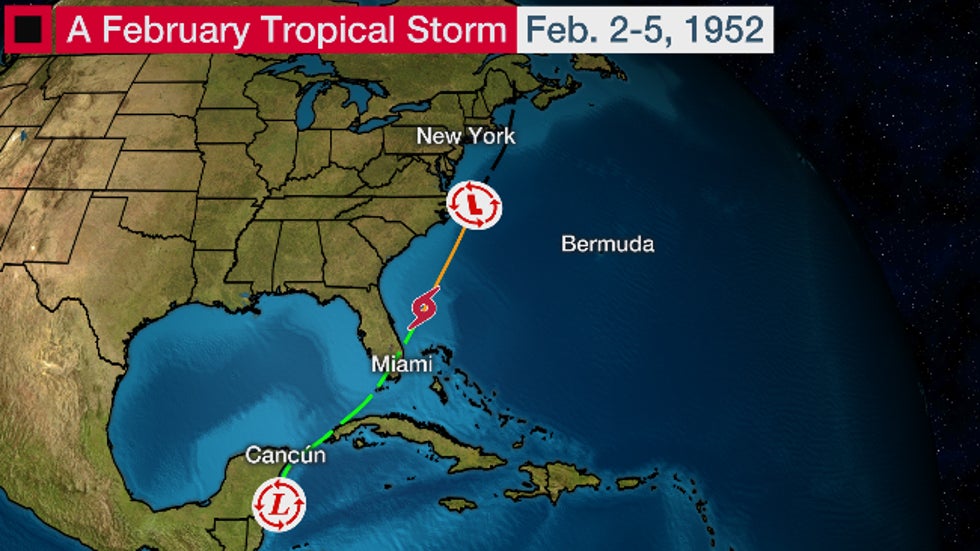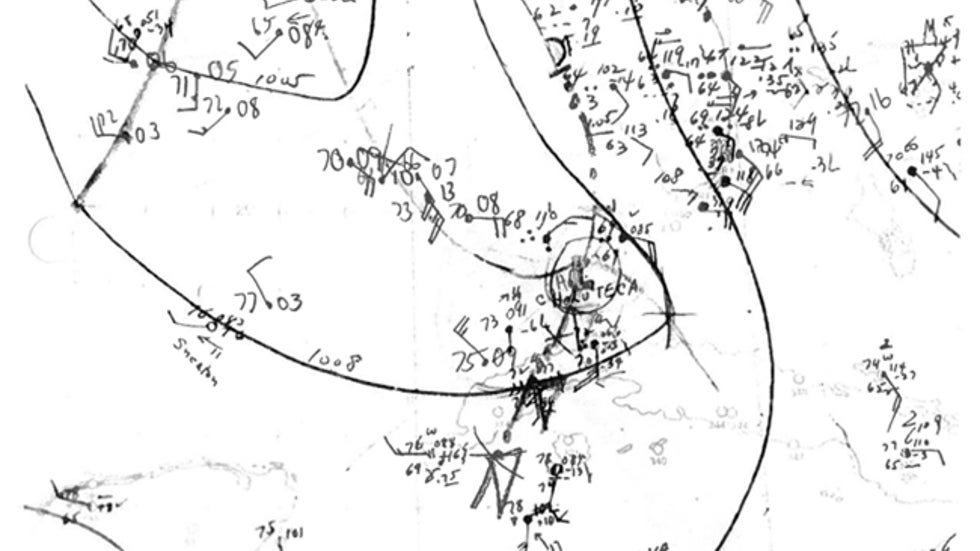Jonathan Erdman
 Track history of the February 1952 tropical storm. The dashed green line indicates the system's track as a tropical low. The orange line indicates the time during which it was briefly a tropical storm. The black dashed line up the Eastern seaboard indicates its track as a non-tropical low.
Track history of the February 1952 tropical storm. The dashed green line indicates the system's track as a tropical low. The orange line indicates the time during which it was briefly a tropical storm. The black dashed line up the Eastern seaboard indicates its track as a non-tropical low.February may be a winter month, but a tropical storm once formed near the East Coast just after Groundhog Day.
This bizarre system, the only known February Atlantic Basin tropical storm, originated as an area of low pressure near Cozumel, Mexico, on the morning of Groundhog Day 1952.
But even the presence of a closed low-pressure center in the Caribbean Sea in early February was initially in doubt.
A communication at the time from the U.S. Weather Bureau, now the National Weather Service, expressed some disagreement between weather bureau offices about a surface weather analysis.
"Your estimate of (a) closed low in (the) Caribbean (is) completely unfounded on (the) basis of our reports. Tropical storms do not form in February."
What Forecasters Didn't Have In The 1950s
Forecasters in the early 1950s did not have several tools considered essential for forecasts today.
First and foremost, there was no satellite imagery. The first U.S. weather satellite, TIROS-1, wasn't launched until 1960, and routine satellite coverage over the tropical Atlantic Basin didn't happen until the mid-1960s.
Secondly, as documented in the comments from NOAA's Hurricane Research Division's Reanalysis Project, flight-level winds from Hurricane Hunter missions in the 1950s weren't reliable and involved manual calculations and estimations.
Finally, it was several years before computer forecast models became available to forecasters.
Impactful, Before It Was A 'Storm'
At any rate, this area of low pressure raced into the southeastern Gulf of Mexico and brushed the Florida Keys before crashing ashore in southwest Florida near Cape Sable after 10 p.m. on Feb. 2, 1952.
 Surface analysis from the U.S. Weather Bureau on Feb. 2, 1952, at 7 p.m. EST. The tropical low, indicated in the center of this map, was just west of the Lower Keys at the time, headed toward South Florida later that evening.
Surface analysis from the U.S. Weather Bureau on Feb. 2, 1952, at 7 p.m. EST. The tropical low, indicated in the center of this map, was just west of the Lower Keys at the time, headed toward South Florida later that evening.The Groundhog Day storm caught some by surprise.
A wind gust up to 84 mph was recorded in a Miami Beach thunderstorm, and tropical-storm-force winds were observed both in downtown Miami and at Miami International Airport.
The combination of strong winds and 2 to 4 inches of rain downed power lines and damaged vegetable crops in South Florida.
The next day, the system emerged off Florida's Atlantic coast, then raced north-northeast paralleling the East Coast until it moved into coastal Maine as a remnant low-pressure system on Feb. 4.
The Investigation
In 2015, as part of the ongoing Atlantic Hurricane Database Reanalysis Project, NOAA's Hurricane Research Division completed an investigation of storms from 1951 to 1955.
They concluded that the February 1952 system briefly was a tropical storm off the southeastern U.S. coast for 18 hours beginning on Feb. 3, before transitioning to a post-tropical low east of North Carolina's Outer Banks early the following morning.
NOAA-HRD estimated the storm reached peak intensity with winds of 70 mph, borderline hurricane strength, well off the coast of the Carolinas before making the transition to a post-tropical low.
Despite this comprehensive investigation, it's still not certain it was ever a fully tropical system.
"Overall, it is likely that if one had satellite imagery, that today this system would be considered a subtropical storm," wrote NOAA-HRD in their reanalysis comments on the storm. These are storms that have characteristics both of tropical storms, but also of low-pressure systems attached to cold and warm fronts in more northern latitudes.
The June-November Atlantic hurricane season includes roughly 97% of all tropical storms and hurricanes.
While this 1952 storm was the only February Atlantic tropical storm in records dating to the mid-19th century, there have been other out-of-season storms through the years, including a January hurricane in 2016 and a March hurricane in the early 20th century.
The Weather Company’s primary journalistic mission is to report on breaking weather news, the environment and the importance of science to our lives. This story does not necessarily represent the position of our parent company, IBM.
The Weather Company’s primary journalistic mission is to report on breaking weather news, the environment and the importance of science to our lives. This story does not necessarily represent the position of our parent company, IBM.

No comments:
Post a Comment